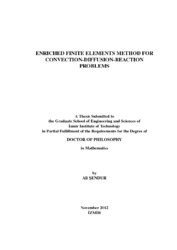Please use this identifier to cite or link to this item:
https://hdl.handle.net/11147/2939Full metadata record
| DC Field | Value | Language |
|---|---|---|
| dc.contributor.advisor | Pashaev, Oktay | - |
| dc.contributor.author | Şendur, Ali | - |
| dc.date.accessioned | 2014-07-22T13:48:38Z | - |
| dc.date.available | 2014-07-22T13:48:38Z | - |
| dc.date.issued | 2012 | - |
| dc.identifier.uri | http://hdl.handle.net/11147/2939 | - |
| dc.description | Thesis (Doctoral)--Izmir Institute of Technology, Mathematics, Izmir, 2012 | en_US |
| dc.description | Includes bibliographical references (leaves: 101-104) | en_US |
| dc.description | Text in English; Abstract: Turkish and English | en_US |
| dc.description | xi, 104 leaves | en_US |
| dc.description | Full text release delayed at author's request until 2015.11.23 | en_US |
| dc.description.abstract | In this thesis, we consider stabilization techniques for linear convection-diffusionreaction (CDR) problems. The survey begins with two stabilization techniques: streamline upwind Petrov-Galerkin method (SUPG) and Residual-free bubbles method (RFB). We briefly recall the general ideas behind them, trying to underline their potentials and limitations. Next, we propose a stabilization technique for one-dimensional CDR problems based on the RFB method and particularly designed to treat the most interesting case of small diffusion. We replace the RFB functions by their cheap, yet efficient approximations which retain the same qualitative behavior. The approximate bubbles are computed on a suitable sub-grid, the choice of whose nodes are critical and determined by minimizing the residual of a local problem. The resulting numerical method has similar stability features with the RFB method for the whole range of problem parameters. We also note that the location of the sub-grid nodes suggested by the strategy herein coincides with the one described by Brezzi and his coworkers. Next, the approach in one-dimensional case is extended to two-dimensional CDR problems. Based on the numerical experiences gained with this work, the pseudo RFBs retain the stability features of RFBs for the whole range of problem parameters. Finally, a numerical scheme for one-dimensional time-dependent CDR problem is studied. A numerical approximation with the Crank-Nicolson operator for time and a recent method suggested by Neslitürk and his coworkers for the space discretization is constructed. Numerical results confirm the good performance of the method. | en_US |
| dc.language.iso | en | en_US |
| dc.publisher | Izmir Institute of Technology | en_US |
| dc.rights | info:eu-repo/semantics/openAccess | en_US |
| dc.subject.lcsh | Finite element method | en |
| dc.subject.lcsh | Diffusion | en |
| dc.subject.lcsh | Reaction-diffusion equations | en |
| dc.title | Enriched Finite Elements Method for Convevtion-Diffusion Problems | en_US |
| dc.type | Doctoral Thesis | en_US |
| dc.authorid | 0000-0001-8628-5497 | - |
| dc.institutionauthor | Şendur, Ali | - |
| dc.department | Thesis (Doctoral)--İzmir Institute of Technology, Mathematics | en_US |
| dc.relation.publicationcategory | Tez | en_US |
| dc.identifier.wosquality | N/A | - |
| dc.identifier.scopusquality | N/A | - |
| item.openairecristype | http://purl.org/coar/resource_type/c_18cf | - |
| item.languageiso639-1 | en | - |
| item.openairetype | Doctoral Thesis | - |
| item.grantfulltext | open | - |
| item.fulltext | With Fulltext | - |
| item.cerifentitytype | Publications | - |
| Appears in Collections: | Phd Degree / Doktora | |
Files in This Item:
| File | Description | Size | Format | |
|---|---|---|---|---|
| 449311.pdf | DoctoralThesis | 2.01 MB | Adobe PDF |  View/Open |
CORE Recommender
Page view(s)
248
checked on Mar 31, 2025
Download(s)
86
checked on Mar 31, 2025
Google ScholarTM
Check
Items in GCRIS Repository are protected by copyright, with all rights reserved, unless otherwise indicated.